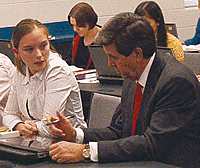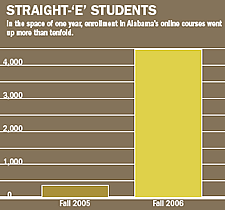Alabama: 'On the Wave of the Future'
##AUTHORSPLIT##<--->
Alabama’s new distance learning program is setto transform teaching and learning in the state.
ALABAMA HAS EMBARKED on an ambitious new distance learning program, with the goal of providing every student with the education necessary to be successful in the global economy. The central concept of the plan is to offer underserved schools with advanced courses and additional course electives through a statewide network. The program has been blazed by the vision and leadership of Gov. Bob Riley, the Alabama Board of Education, and Superintendentof Education Joe Morton.

LEADING THE WAY: Gov. Bob Riley has
been a driving forcebehind Alabama’s new
statewide eLearning project.
In the fall of 2004, Gov. Riley appointed a task force, led by the Alabama Department of Education, to bring all stakeholders together to plan a distance learning initiative. Partners included universities throughout Alabama, local school districts, Alabama Public Television, the BellSouth Foundation, the Southern Regional Education Board, the Appalachian Regional Commission, and the Alabama Supercomputer Authority. The task force initiated a multiphased program titled ACCESS Distance Learning (Alabama Connecting Classrooms, Educators and Students Statewide; www.accessdl.state.al.us). The initiative aimed to move the limited distance learning occurring from the disparate school system level to a statewide level, develop state policy, create partnerships with corporate sponsors, and collaborate with multiple universities and school systems.
As we move on the fast track toward implementing statewide distance learning in Alabama, we will have gone from our fall 2005 total of 425 students enrolled, with 21 course offerings and fewer than 8 percent of school districts sharing teachers via interactive videoconferencing (IVC), to potentially more than 4,500 students in more than 42 different courses (either IVC or web-based) in the fall of 2006, along with 44 percent of the school districts sharing teachers via IVC.
According to Martha Donaldson, distance learning administrator with the Education Department, “Combining challenging courses, excellence in teaching, and variety in course offerings, Alabama’s ACCESS Distance Learning initiative meets the unique curricular needs of students statewide.”
Initial funding for the prgram was provided by the Alabama Legislature in October 2005, at $10.3 million dollars, with the same amount appropriated for a second year. Thanks to the funding, ACCESS Distance Learning courses are being provided free to public high school students. The funds also provide incentives for delivery schools to share teachers, as well as for teachers to learn course delivery using technology tools.
Blending Technologies
The task force examined a number of distance learning models, including the Florida Virtual School, and by implementing parts of each one, created a hybrid that is suited for delivery by state government. In addition, the state is building an extensive support structure for teachers and students, applying expertise from higher education and other stakeholders.
One of the goals of the ACCESS Distance Learning program is to adopt several strategies that leverage the existing resources in Alabama. Research shows that 115 of the 470 high schools in the state have invested in H.323 IVC labs.
One of the strategies at work is to connect all 115 existing labs in order to provide broadband connectivity (10 Mbps) to the state educational network, and to enable quality of service (QoS) network connectivity to other IVC sites in the state through the Alabama Supercomputer Authority. Since no special point-to-point dedicated lines are needed, this is an added incentive for districts to participate. Additional internet broadband connectivity can be used not only for distance learning, but also for internet usage and transmission of secure data to the state. By the end of the second year of implementation, we plan to install broadband connectivity in all 470 high schools.
What is different about the Alabama model? First, we are implementing two parallel models of distance learning—IVC and web-based course delivery. As the project progresses, we plan to develop a blended model for the two technologies.
Our first step when we undertook the program was to deploy the two models in 24 pilot sites. A grant covered IVC equipment, broadband connectivity with QoS, classroom tablet computers, training, online course content, online mentors, and support from the state.
The pilot sites started the delivery of their first classes in January, involving more than 1,145 students in seven online courses and 19 IVC courses. Online class enrollment totaled 305 students; the IVC courses served 840 students—of which 340 were being reached at a distance. Additional pilot sites are expected to be awarded later this summer.
In the fall, pilot sites will blend IVC technology with online technology through a learning management system (LMS) for assignments, communication, and projects. They will also employ tablet software that allows distance teachers to direct collaborative note-taking, classroom interaction, and computer monitoring. During class, teachers will be able to post an assignment or administer a test on the LMS, and students can use their tablet PCs to respond.
The software also allows teachers to display on the students’ tablets whatever is written on their own computers, to which the students can then respond. This is a great feature to incorporate into math classes, where teachers and students can work out problems on the tablets in real time.
Many IVC classes will also have complete webbased course content for teachers to use and assign to students. Teachers will find this useful whenever certain distance learning classes are not in session, such as during spring break, or when one school has a special assembly and another does not. We anticipate that using a synchronized learning model with web-based course content will help districts overcome the challenges they encounter when dealing with different schools using different calendars and staging different special activities.
 In addition, the pilot sites will blend the web-based course delivery model with real-time student-teacher interaction using web conferencing software and/or virtual field trips, in order to meet the face-to-face need identified by students. “The most exciting part of working with ACCESS Distance Learning pilot schools,” says Cindy Ham, distance learning specialist for the Alabama Department of Education, “has been to watch the acceptance of the program by principals as they realize the unlimited possibilities for their students.”
In addition, the pilot sites will blend the web-based course delivery model with real-time student-teacher interaction using web conferencing software and/or virtual field trips, in order to meet the face-to-face need identified by students. “The most exciting part of working with ACCESS Distance Learning pilot schools,” says Cindy Ham, distance learning specialist for the Alabama Department of Education, “has been to watch the acceptance of the program by principals as they realize the unlimited possibilities for their students.”
One of those principals is White Plains High School’s Davine Miller, who suggests that the IVC technology allows students to see and interact with other students to “become familiar with and understand the impact of technology whileintroducing them to an expanded world.”
Statewide IVC Delivery
A related strategy the state is incorporating is the scheduling and sharing of teachers among school districts using IVC delivery. Money, as it so often is, is the incentive here. The districts that have certified, highly qualified teachers, extra seats for students, and IVC equipment will receive funds for every student seat they deliver to schools outside their districts. Ozark City Schools Superintendent Daniel Payant says, “Since we are such a small school district, it will now be cost-effective for us to hire a French teacher, as before we could only utilize their expertise part of the day.” The state will monitor to ensure that student class counts (including those at a distance) do not exceed standards.
Some schools in Alabama had been enrolling students in basic online courses for a fee. With Alabama ACCESS Distance Learning, enrollment will now be free, and there will be an extensive course catalog, including Advanced Placement classes and additional electives. These 32 different courses are currently being purchased, rewritten, and aligned to Alabama content standards, and then loaded into the state LMS.
A secure online registration and management system is being implemented so schools can request courses for students, document receipt of permissions and signed polices, communicate with distance learning teachers, monitor student progress, and view grades.
Another way to save money and ensure the system is used well is to provide the highest-quality support possible. With the implementation of the new distance learning initiative, two universities and a local school system have been awarded new roles: ACCESS Distance Learning support centers. The primary role of the support centers is similar to one of the functions of a local school system: Hire and manage online instructors and provide them with support.
Each support center will train online teachers using both web-based course delivery strategies and IVC, blended with cutting-edge technology and software. The training will involve online sessions, face-to-face meetings, and mentoring. The support centers will ensure that e-teachers are available for parent-teacher conferences and tutoring by way of telephone, video, web conferencing, or online chat rooms. A technical support desk will be in operation at least 12 hours per day for a minimum of five days per week.
Looking Ahead
An outside evaluator, the International Society for Technology in Education, has been retained, with its final analysis of the pilot phase of the program due out in early 2007. Surveys, interviews, and data analysis are currently taking place in the 24 pilot sites to determine whether the goals of the project are being met, and what exactly isessential for the success of each student.
The ACCESS Distance Learning task force is in the process of writing up plans for the second and third years of the project. ACCESS offers much more than distance learning; we are establishing classrooms of the future in our schools, equipped with IVC equipment, tablet computers with wireless access points, broadband connectivity, various types of communication and student engagement software, and access to state-approved, state-owned course content. Our hope is that this effort will profoundly reform Alabama’s high schools. The blended model will allow us to have that kind of impact.
Ultimately, it may be that the ACCESS project will jumpstart 1-to-1 initiatives in the state, as well as help advance a move toward creating an LMS login for every high school student and having every high school teacher employ the software in their face-to-face classes. We are either purchasing course content that we own the rights to, or we’re developing course content ourselves, so we will be able to give high school teachers access to any of the course content for future use in traditional classes.
Testifying to the power of the program, Jared Felkins wrote in the Sand Mountain Reporter: “The words ‘technologically advanced’ do not begin to explain what I witnessed at Boaz High School. I was in awe when the students came in. Each pulled out a laptop and a graphing calculator and opened them up. Apparently, the days of pencil and pad are over. All were eager to learn AP calculus, and rightfully so, since the students volunteered for this class. In short, ACCESS Distance Learning will soon revolutionize the way we look at high school education in Alabama.”
The most exciting part of working with ACCESS Distance Learningpilot schools has been to watch the acceptance of the program byprincipals as they realize the unlimited possibilities for their students.
Cindy Ham, Alabama Department of Education
This is an exciting time to be in education. Changing the level of engagement students take on in their own education process can make a difference in transforming the traditional high school class. The ACCESS Distance Learning project has put Alabama “on the wave of the future,” says Earlene Patton, distance learning administrator. Check back with us in six months. We expect that wave will be advancing even further.
Melinda Maddox is technology director for the state of Alabama and the treasurer of SETDA’s board of directors.